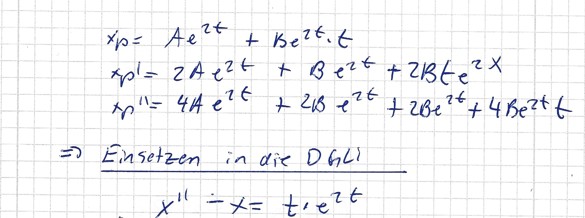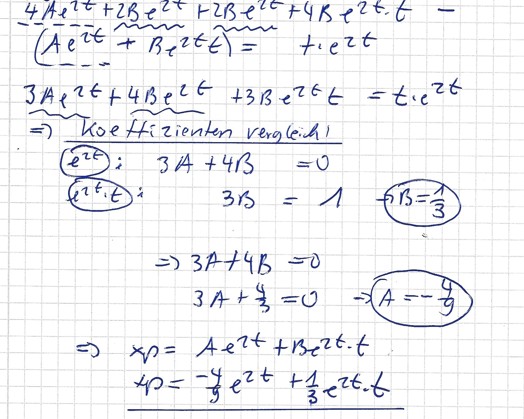Hallo,
Ansatz x(t)= e^(λt) , 2mal ableiten , ergibt:
λ^2 -1=0
λ =± 1
\( \lambda=-1 \) ergibt \( x_{1}(t)=C_{1} e^{-t} \);
\( \lambda=1 \) ergibt \( x_{2}(t)=C_{2} e^{t} \)
\( xh(t)=x_{1}(t)+x_{2}(t)=C_{1} e^{-t}+C_{2} e^{t} \)
Ansatz part.Lösung:
Ist \( \mathrm{g}(\mathrm{x}) \) eine Summe/ein Produkt , so ist als Ansatzfunktion ebenfalls eine Summe/ein Produkt solcher Funktionen anzusetzen.
g(x) - Störfunktion, rechter Teil der Gleichung
t : a +bt
e^(2t): c *e^(2t)
------->
xp= (a +bt) * c *e^(2t)
xp= a c *e^(2t) + bt c *e^(2t)
xp= A *e^(2t) + Bt *e^(2t)
\( x_{p}(t)=A e^{2 t}+B e^{2 t} t \)
->2, Mal ableiten , in die DGL einsetzen, Koeffizientenvergleich


\( x_{p}(t)=-\frac{4 e^{2 t}}{9}+\frac{1}{3} e^{2 t} t \)
x=xh+xp
Lösung:
\( x(t)=C_{2} e^{t}+C_{1} e^{-t}+\frac{1}{3} e^{2 t} t-\frac{4 e^{2 t}}{9} \)